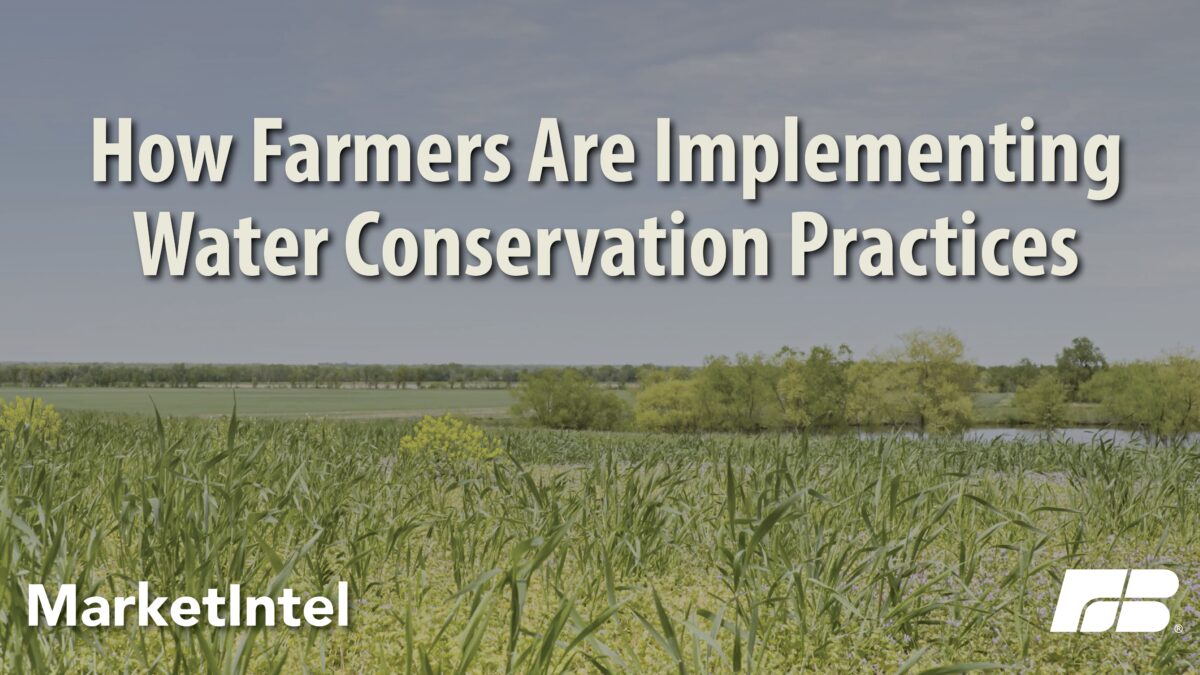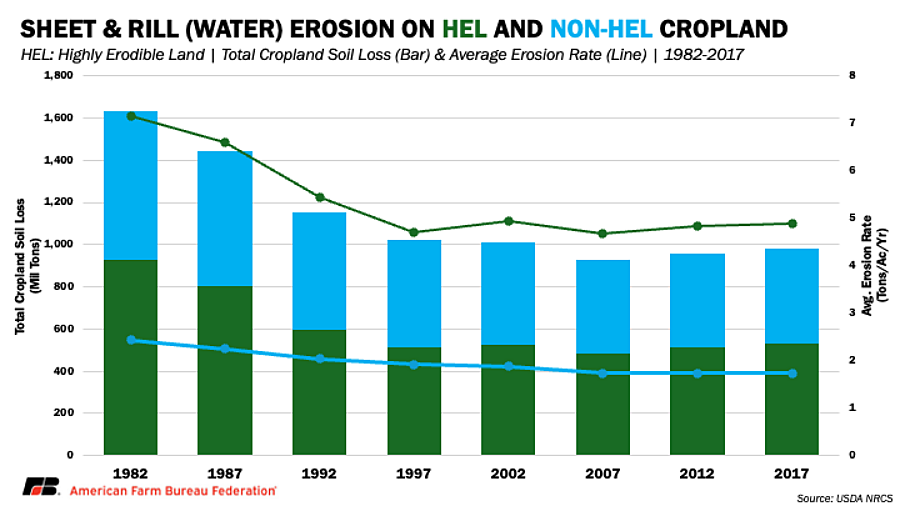Water Quality a Priority for Farmers and Ranchers

Samantha Ayoub
Economist
Water is a crucial resource for farmers and ranchers. Beyond keeping their crops, forage and livestock healthy and growing, the water used on the farm is also part of their families’ and communities’ water supply. This Market Intel details the many ways farmers and ranchers protect water quality.
Water Conservation Practices
There are several practices farmers and ranchers use to preserve water quality, with a focus on improving land’s water retention, keeping water and nutrients in a field, and reducing runoff.
Conservation Tillage and Year-Round Ground Cover
Conservation tillage and cover cropping, often discussed together as soil conservation practices, not only protect against erosion but also improve soil water retention and reduce runoff, helping keep water and nutrients such as fertilizer in the field. Reducing soil disturbances from tillage prevents loose soil and water from sitting on top of dense, compacted layers below the surface that restrict water filtration and keeps past crop residue on the field. Conservation tillage also creates barriers for rainwater and any runoff, trapping water and sediment on the field to absorb into the soil.
Planting crops year-round, whether traditional cover crops or two cash crops, reduces exposed soil and allows the soil to continue to absorb nutrients that may otherwise runoff into water sources.
The use of both conservation tillage and cover cropping continues to increase. Conservation tillage, including no-till, was used on over 202 million acres, more than half of all cropland, in 2022. In 2023, over 37.8 million acres were enrolled in programs to receive either financial or technical assistance from USDA’s Natural Resources Conservation Services (NRCS) to implement or improve no-till, making up 3.5% of all acres enrolled in NRCS programs. Just under 30 million acres nationwide were also receiving assistance for reduced tillage, 2.7% of NRCS enrollment. They represent the 10th- and 13th-top NRCS practice applied, respectively, reflecting their long-term stance as leading conservation practices. Many farms now complete conservation tillage without NRCS assistance with over 200 million acres nationwide using conservation or no till in 2022.
Cover cropping rotations remain the third-most utilized NRCS practice applied – likely due to the longer-term investment required to see returns. Cover cropping assistance programs are applied on over 86 million acres, 7.9% of acres receiving NRCS guidance. An additional 21 million acres are receiving assistance for conservation cover, ensuring a vegetative cover is on any exposed soil, such as between plants in orchards or vineyards, to reduce erosion.
Conservation Drainage
Managing the amount and rate of water leaving fields is crucial to preserving topsoil and preventing nutrient runoff, particularly in areas of the United States that receive large amounts of precipitation. There are some conservation practices to reduce the amount of water, sediment and nutrients that end up in local streams.
Conservation drainage management allows farmers to retain water during dry periods and drain excess water when needed. Constructed wetlands – those developed for specific water filtration needs, not naturally occurring wetlands – and drainage water recycling systems capture the water coming out of drainage systems and other runoff and treats the water before it reaches waterways. Bioreactors filled with carbon sources like wood chips remove nitrates from drainage water through denitrification.
Buffer strips and saturated buffers are pieces of land along the edges of crop fields with vegetation to intercept nutrients from drainage or runoff, giving them a place to absorb on land and preventing them from reaching waterways. Saturated buffers are designed to work with tile drainage to drain water from the drainage line into the ground of the buffer where the soil itself becomes saturated, allowing vegetation and soil organisms to remove nutrients from the water before it is discharged into streams.
According to NRCS, the use of conservation practices reduced cropland soil water erosion by over 40% in 45 years. Over the past 45 years, erosion on less vulnerable land has steadily declined, while erosion on highly erodible land fell sharply in the late 20th century but has since leveled off. In total, the average acre of cropland has reduced water erosion by 31% in the last 40 years, reflecting farmer’s work to maintain their soil.
Nutrient Management
Correctly and efficiently applying nutrients is one of the most impactful ways farmers preserve water quality. Nutrient management typically involves the 4 “Rs”: applying the right kind of nutrients at the right rate, at the right time, in the right place. These principles optimize crop yields while minimizing excess nutrients that may run off the fields. To ensure proper nutrient levels, farmers utilize soil testing to measure soil characteristics. Adjusting nutrient levels to accommodate the 4 R’s and ensure proper soil levels may include splitting applications into multiple small doses to ensure the nutrients absorb rather than running off, varying types of fertilizer, and considering environmental aspects. Factors like crop type – including previous crop rotations – soil type and weather patterns can all impact nutrient management.
Modern technology also continues to aid in effective nutrient management. Precision agriculture technologies allow for variable-rate application based on field conditions, soil needs and yield maps, continuing to ensure nutrients are applied at the right rate in the right place at a more granular level.
Nutrient management plans are the eighth-most utilized NRCS practice applied on U.S. farms and ranches. Nearly 54.6 million acres are actively receiving assistance in improving their nutrient application strategies. Especially as fertilizer prices remain high, efficient use of nutrients is important for both farm sustainability and environmental quality. Farmers are expected to spend over $55 billion in fertilizer and chemicals in 2025, adding to record breaking production expenses. These factors continue to drive investments in technology and management plans that allow farmers to mitigate their input usage, aiding in environmental quality as less nutrients are overapplied; each dollar of nutrients washed away could be the dollar between breaking even and losing money on an acre when operating in this tight crop economy.
Livestock Management
Livestock producers protect water quality by controlling animal waste and movement. Manure management – keeping waste confined to structures that prevent seepage into water sources, like lagoons or concrete structures – is particularly important where animals are kept in high density or indoors. There are also technologies, like anaerobic digestors or separation systems, that convert manure into by-products, like renewable fuel or fiber that can used as bedding, and treatable water. Waste may also be used in nutrient management plans on crop fields, providing a management source for livestock waste while also giving crops nutrients. Following the 4R principles of nutrient management cuts down on animal waste runoff from crop fields and contributes to conservation from both livestock and crop farmers.
Other livestock considerations may be as simple as strategic fence placement to keep livestock out of streams or sensitive areas. Over 53 million acres receive NRCS assistance for fence installation. Keeping livestock out of streams or waterways eliminates waste from being deposited into waterways while also protecting streambanks from degradation and erosion. This often includes providing alternative water sources, accounting for the fourth- and sixth-most utilized NRCS practices nationwide, watering facilities and livestock pipelines, respectively.
From an erosion standpoint, prescribed grazing ensures pasture and rangeland maintains vegetative cover and prevents sediment from washing into waterways. Prescribed grazing involves rotating where animals are grazing for set amounts of time as well as controlling the density of animals on a piece of land at one time. This conservation practice not only helps protect water quality, it also preserves a constant source of forage for livestock, hopefully diminishing the need for secondary feeding sources. Prescribed grazing is the most used NRCS conservation practice, being utilized on over 271 million acres, over 26% of acres receiving assistance. Many conservation practices like prescribed grazing improve multiple environmental elements – soil, water, air.
Conclusion
Farmers and ranchers prioritize water conservation. Maintaining healthy water systems is critical not only to the long-term viability of their farms and ranches, but also to their communities. Various farming practices, alone or in conjunction, work to keep needed soil and nutrients on fields, and out of the water sources that their families and their communities rely on.
While farmers and ranchers continue to utilize conservation practices on their individual farms, protecting water sources is a joint effort with their communities, including their urban counterparts. Efforts may be as vast as the entire Mississippi River Basin or Chesapeake Bay, or as limited in scope as a local county working with private partners to improve water quality through an NRCS watershed project. Regardless of the size of the project, farmers and ranchers play a crucial role in improving and protecting water for their crops and livestock, their families and their communities.
Top Issues
VIEW ALL
